Prescription Trends of Initial Pharmacotherapy for Benign Prostatic Hyperplasia Among Treatment-Naïve Patients in South Korea: A Retrospective Analysis
Abstract
Background
Benign prostatic hyperplasia (BPH) is a common urological condition in aging men that causes lower urinary tract symptoms. Pharmacotherapy is central to BPH management; however, considering updated guidelines, recent prescription trends remain insufficiently explored. This study aimed to assess initial pharmacotherapy trends in patients newly diagnosed with BPH.
Methods
This cross-sectional analysis used 2015–2020 data from the Health Insurance Review and Assessment Service to examine the trends and influencing factors of BPH drug utilization among South Korean patients aged ≥ 40 years with no prior history of BPH. Subgroup analyses were performed by categorizing patients into five age groups (40–49, 50–59, 60–69, 70–79, and ≥ 80 years) to evaluate age-specific prescription patterns.
Results
Of the 1,445,144 patients newly diagnosed with BPH, 1,336,695 (92.4%) initiated treatment within 60 days of diagnosis. Among those treated, 54.9% received α-blocker (AB) monotherapy and 17.9% received 5α-reductase inhibitor (5-ARI)/AB combinations. Use of 5-ARI/AB combinations increased with age, from 8.0% in patients in their 40s to 25.4% in those aged ≥ 80 years. Tamsulosin (a selective AB), dutasteride (a 5-ARI), and mirabegron (a β3-agonist) were the most frequently prescribed agents.
Conclusion
Recent American Urological Association (AUA) guidelines recommend combination therapy as an effective strategy for reducing the risk of BPH-related complications. Although the largest proportion of patients was prescribed AB monotherapy, the growing adoption of combination therapy in South Korea, particularly among older age groups, suggests a shift toward more guideline-concordant and effective therapeutic approaches.


 求助内容:
求助内容: 应助结果提醒方式:
应助结果提醒方式:


